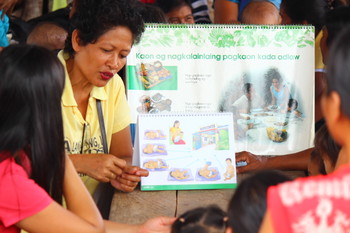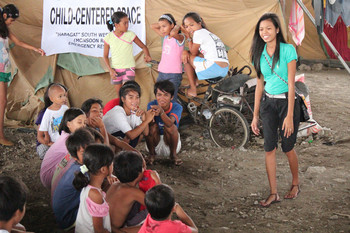Site will be
unavailable for maintenance from June. 4, 11:30 p.m., to June 5, 12:30 a.m. ET. Thank you for your
patience!
Closing the Social Inequality Gap in the Philippines
Posted on 07/22/2013
(Updated on 03/04/2021)
Poverty doesn't just make it difficult for families to survive, it can also have much wider economic impact. In the Philippines, where more than a quarter of the country's population of 92.3 million lives below the poverty line, economic and social inequality is a major problem. The Philippines has one of the highest rates of income inequality in the world, and unless action is taken, the gap will continue to widen. ChildFund has operated in the Philippines since 1954 and works to ensure the nation's poorest children and their families have access to the food, health care and education they need to survive.

A woman trains pregnant women and new mothers as part of ChildFund's work with communities to combat malnutrition after Typhoon Haiyan.
Persistent Problems
According to the ASEAN Trade Union Council, the Philippines has the third highest rate of economic and social inequality in Southeast Asia. This problem is not limited to personal wealth. Land distribution, educational and vocational opportunities and basic welfare programs are also affected by the growing disparity between the Philippines' richest and poorest citizens.
As economic inequality has become more pronounced in the past decade, geographical disparity has grown in the Philippines. In Mindanao, the southernmost and second largest of the Philippines' islands, six of the 10 regions are among the top 10 nationally in terms of poverty rates, with between 25 and 40 percent of families living in abject poverty. Nationwide, the 30 most deprived provinces are home to more than one-third of the Philippines' poorest families, resulting in generational poverty that is incredibly difficult to escape.
As in many other parts of the world, it is often the indigenous population that suffers the most. In the Philippines, the approximately 1.7 million people belonging to the nation's 100 ethnic groups remain the most disadvantaged, with discrimination and a lack of opportunities creating serious barriers.
Building a Foundation
Economic and social inequality are complex problems, but they can be addressed by governments and aid organizations working together to ensure that opportunities are more readily available for the nation's poorest people.

A young woman leads activities with a group of children at a child-centered space in a flood evacuation center south of Manila.
"The key to reducing inequality is better education, better healthcare, social safety nets and higher and broader economic growth, especially in agriculture," Edwin Lacierda, a spokesman for the president of the Philippines, said in a news briefing in Manila.
The government of the Philippines is working to expand access to health care, education and land ownership among the country's poorest families, but the road to recovery and improved equality is long. To aid in these efforts, ChildFund has worked to provide increased resources to children in need and help them break the cycle of poverty.
Last year, we provided home and center-based early childhood development services to more than 8,000 children in the Philippines' poorest provinces. Children enrolled in these programs receive nutritious food and educational opportunities, and parents are trained in areas like nutrition and basic health care.
ChildFund also supports programs that have led to more than 19,000 at-risk children staying in school. Tutoring programs, developed in partnership with the Philippines government's Department of Education, have yielded improvement in crucial areas such as English, math and science, building a strong foundation upon which children can continue their education.
Despite these accomplishments, more families need our help. The best way to give a Filipino child access to the resources he or she desperately needs is to sponsor a child. Your support will let a child have a greater chance for a fulfilling future.
Loading...



